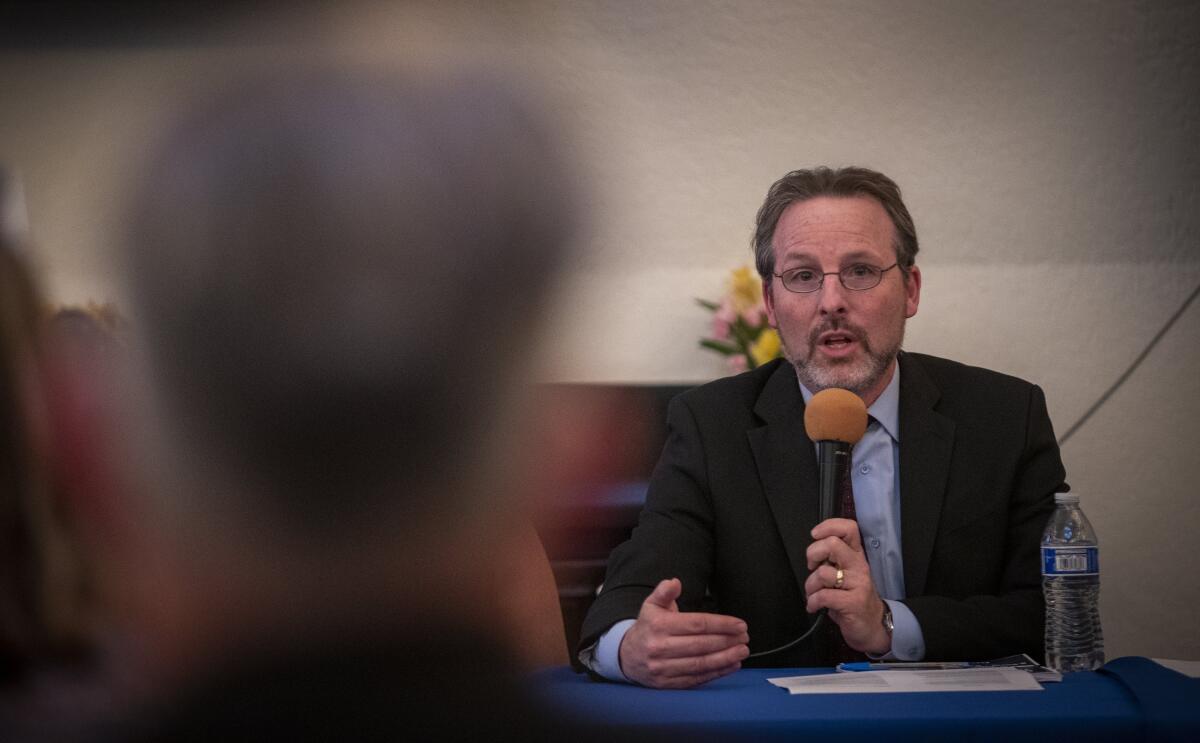Forensic expert’s flawed DNA analysis leads to release of O.C. murder defendant, D.A.’s review

- Share via
Orange County prosecutors are reviewing cases worked on by a DNA expert who has been accused by defense attorneys of altering her analyses to help win convictions.
The probe will first target active homicide cases and then the rest of the cases Mary Hong was involved in during her more than 30 years with the Orange County Crime Lab.
Defense attorneys have long scrutinized Hong’s work, particularly in two murder cases where they allege that she and other lab employees changed their testimony to suit the needs of prosecutors.
This month, after Hong said she would not be able to repeat her earlier testimony about a 1988 slaying, prosecutors struck a deal with the defendant, Daniel McDermott, who pleaded guilty to voluntary manslaughter.
Assistant Public Defender Scott Sanders said Hong acted as the “crime lab closer” on many of the county’s most serious cases.
“What makes her so dangerous is her enormous skill at persuading jurors that she is merely honoring science when her focus has very much been on making sure cases end in convictions,” said Sanders, who was involved in some cases where Hong’s work has been questioned.
Hong, a senior forensic scientist and DNA supervisor, left the crime lab, which is part of the Orange County Sheriff’s Department, in 2016 and now works for the California Department of Justice.
She declined to comment when reached by phone on Tuesday.
In a statement, O.C. Dist. Atty. Todd Spitzer said: “The mission of the Orange County District Attorney’s Office is not to get convictions at all costs; it is to carefully and methodically evaluate and reevaluate each case to ensure justice is served based on the evidence which can be proven beyond a reasonable doubt.”
McDermott was charged in 2012 with killing 18-year-old Gehmine Chandler, who was found raped and strangled in her Buena Park home decades earlier.
McDermott was questioned by police shortly after Chandler’s death in January 1988 but was not arrested. Years later, advances in DNA technology helped prosecutors build a case against him.
At McDermott’s first trial, in 2016, Hong testified that semen in Chandler’s body belonged to McDermott. She also linked DNA on Chandler’s right wrist to McDermott.
McDermott, now 53, contends that he had sex with Chandler the day before she died but denies killing her, his defense attorney Chuck Hasse said.
That trial ended in a hung jury.
McDermott’s second trial, which began earlier this year, changed course when Hong said she would not be able to testify that McDermott’s DNA was on Chandler’s wrist.
With their case weakened, prosecutors offered McDermott a deal.
Voluntary manslaughter carries a term of 11 years. McDermott had been behind bars awaiting trial since 2012, so he was released over the weekend after his guilty plea.
If convicted of murder, he could have faced life without the possibility of parole.
“As soon as an upcoming witness informed our prosecutor mid-trial that she would no longer be able to testify regarding one of the DNA results, the defense was immediately notified and the case was reevaluated,” Spitzer’s statement said.
Hong was involved in the Chandler investigation from the beginning when she had limited DNA technology to work with.
Back then, she determined that a swab of fluid collected from Chandler’s body was sperm but could not link it to anyone.
When the case was reopened in 2009, Hong found DNA from Chandler’s right wrist that could have come from one or more people, according to court records.
Hong noted in her 2009 reports that the DNA had some markers consistent with the semen from Chandler’s vaginal swabs, which was later linked to McDermott, according to a court filing by Hasse.
But that finding applied only if there was one source of DNA, Hasse wrote. If more than one person’s DNA was on Chandler’s wrist, the DNA “could not be connected to anyone,” Hasse wrote.
In a 2012 analysis, Hong downgraded her assessment of some of the DNA on Chandler’s wrist so that it was not considered a viable sample, according to Hasse.
“She got rid of all the red flags so she could only use the markers that identified my client,” Hasse said.
By that time, protocols in forensic science had shifted so that samples of such poor quality could not be used unless the number of people contributing DNA was firmly established, said Suzanna Ryan, a Carlsbad-based forensic consultant hired by McDermott’s defense team.
“Her protocols at that time in 2012 had changed so that if the data was low-level, which it was, and she did not know how many contributors were present, then the results had to be considered inconclusive,” Ryan said.
Even though Hong is no longer employed by the county, she still testifies in cases she handled.
Kimberly Edds, a spokeswoman for the district attorney’s office, could not specify how many of Hong’s cases the office will review.
On Tuesday, Spitzer said in a statement that the investigation was focusing on active cases. On Wednesday, Edds clarified that the investigation will include all of Hong’s work at the crime lab, but that active homicide cases will be identified first.
Sanders, the assistant public defender, said defense attorneys have been asking for a review of Hong’s cases for years.
The district attorney’s investigation should also include closed cases, Sanders said. Otherwise, defendants who have already been sentenced have few legal options.
“It will only get to the many cases that she impacted through her testimony if there is a meaningful review of past cases,” he said.
All the latest on Orange County from Orange County.
Get our free TimesOC newsletter.
You may occasionally receive promotional content from the Daily Pilot.




